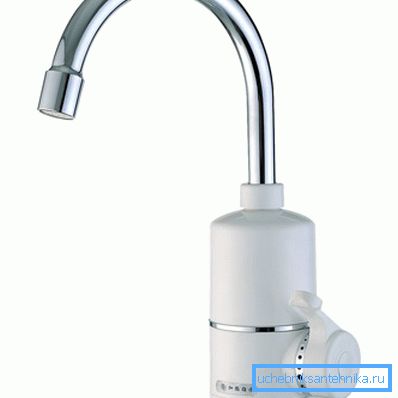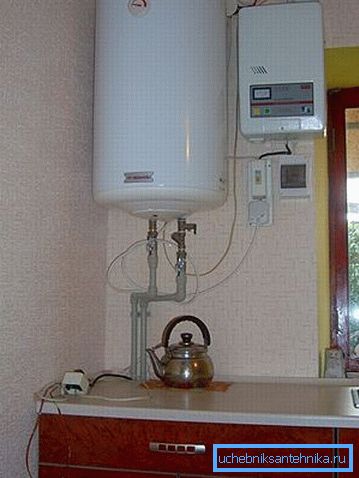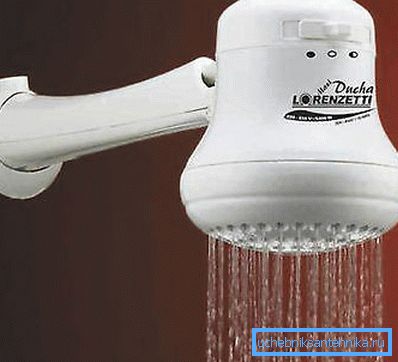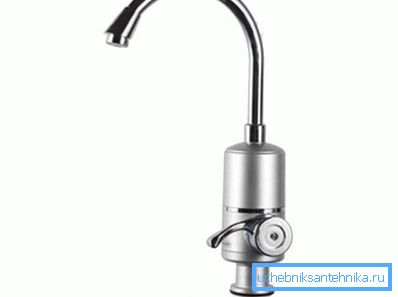Tap for heating water: what to do if the pipes remain cold
Crane instantaneous heating of water is still relatively recently considered a rather exotic device. However, even today, many are skeptical of such constructions, preferring either traditional boilers or wall-mounted flow heaters.
At the same time, in some situations, the installation of such a crane will be fully justified. And in order not to spend money in vain, it is worth exploring the recommendations given in the article for choosing such systems.

Using compact devices
Main situations
The heater on the cold water faucet is usually used in kitchens, more rarely - in washstands. Of course, it is not suitable for a full-fledged water supply, because it provides a fairly small head, but in some situations it can be very useful.

Where should such cranes be used?
- Summer houses and country houses with water supply, but without a centralized supply of hot water - an ideal place to install such a structure. If you live in a summer cottage only in summer, then you should not buy a boiler or a boiler for the heating system - it will not pay off in the foreseeable future. And in order not to wash the dishes and not to wash with cold water, a heated faucet is perfect.

- In a house with independent heating, using the main gas, it is also possible to install this design.. At the same time, in the warm season, to obtain a small volume with hot water, it is not necessary to start the boiler, which will provide substantial savings.
Note! Also, the use of such cranes significantly saves the life of the boiler, which will not turn on, and off every few minutes.
- However, in an apartment with a centralized hot water supply a device for heating water at the tap will also be very useful.. All the advantages of this solution you can appreciate when the housing office turns off the hot water for repair or replacement of pipes.
If your situation fits at least under one of these descriptions, then it’s time to think about buying and installing such a device. However, before making a decision, it is worth examining their advantages and disadvantages.
Pros and cons of water heaters
Tap fast heating water is really quite convenient to use:
- First, you do not need to wait until the liquid heats up to the desired temperature. For quality models, the pause between turning on the system and starting to use it is about 5 seconds.

- Secondly, it is not necessary to allocate a separate place for the installation of the heater. Its dimensions are not much larger than those of a standard faucet, so that it fits on the countertop and on the bathroom cabinet.
- Thirdly, it is very easy to control the system, and by setting the temperature once, we can always use water with the most comfortable degree of heating.
- If necessary, you can install a crane with your own hands, and its simple design makes it easy to perform self-repair.

However, the system has disadvantages:
- Price and workmanship are directly proportional. If you want to get a model with good performance and an adequate safety margin - get ready to pay a fairly large amount. Cheap Chinese models serve no more than a year, and besides, the temperature control sensor periodically fails in them.
- The water heater on the faucet is characterized by high energy intensity (as, however, all flow designs). With economical use it is not so noticeable, but if you use water uncontrollably, then the electricity bill can be unpleasantly surprising.
- Low pressure is the problem of absolutely all products of this type. If you open the tap "to the full", the heater simply will not cope with the large volume of water. So fill the bathroom with this design is unlikely to succeed.

Note! The exception is made by special designs which represent the spherical crane with heating for a shower. However, such products still produce only little-known companies, because talking about their quality is rather difficult.
If these disadvantages do not scare you, then in the next section we will tell you what to look for when buying.
What to look for when buying?
Instructions for the selection of flow-through heater-mixer involves the most complete study of the characteristics of the selected model. It is desirable to pay attention to any little things.
To make it easier for you to navigate, we have entered the main requirements in the table:
| Construction detail | Special features |
| Housing | Preference should be given to metal models, as well as structures made of dense polymers. Cheap plastic cases often either crack or become deformed when exposed to hot water. |
| Heating element | The more powerful this part, the more energy will be consumed by the device, but the faster the heating will be carried out. For domestic use, there is usually enough 3 kW. |
| Safety system | It should include a temperature sensor that controls the temperature of the water, and a built-in RCD that turns off the heating element when the circuit is closed. |
| Heating indicator | A small but very useful element: when a light bulb is on the body of the device, we see that the heating element is working and hot water is coming from the tap. |
| Filter | Usually it is a steel mesh, which catches large pollution. The presence of a complete filter significantly increases the service life of the heating element. |

As for the appearance of such devices, the most common are the white model, suitable for typical kitchen interiors, as well as high-tech devices. However, if you are ready to overpay, you can also find vintage taps with cases of copper, brass or bronze.
Conclusion
A properly selected tap of instant water heating can be not only an interesting gadget, but also a truly useful household appliance. For a more detailed study of such products, we recommend everyone interested to view the video in this article.